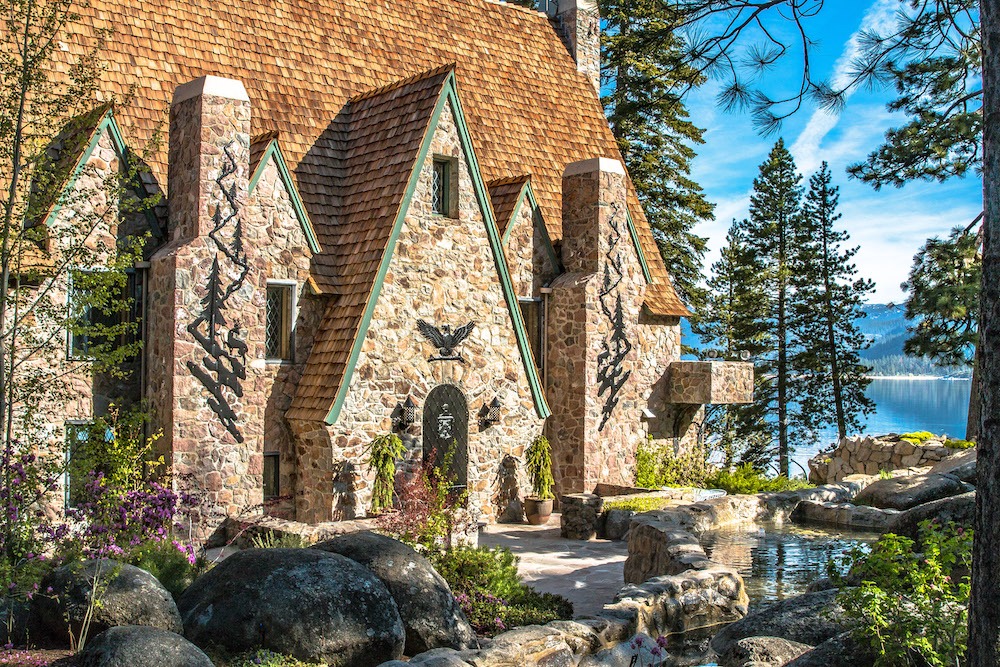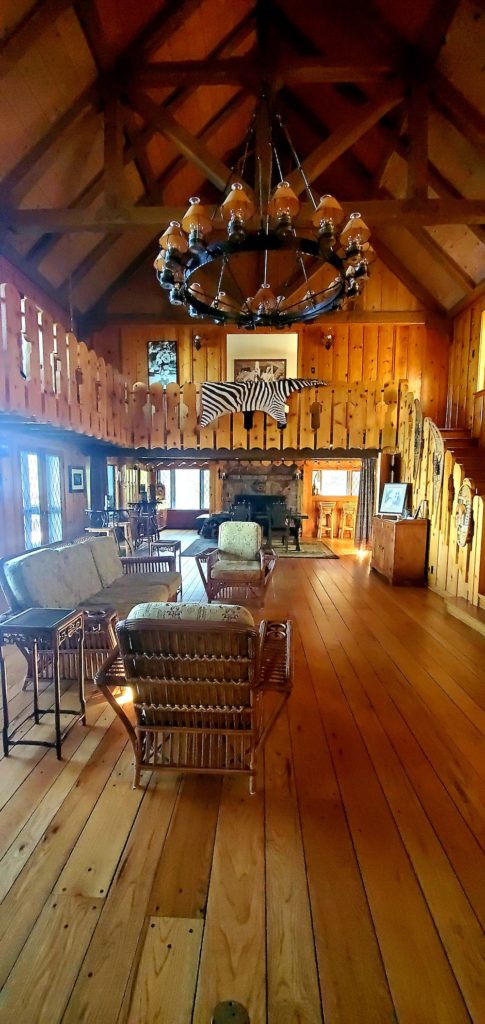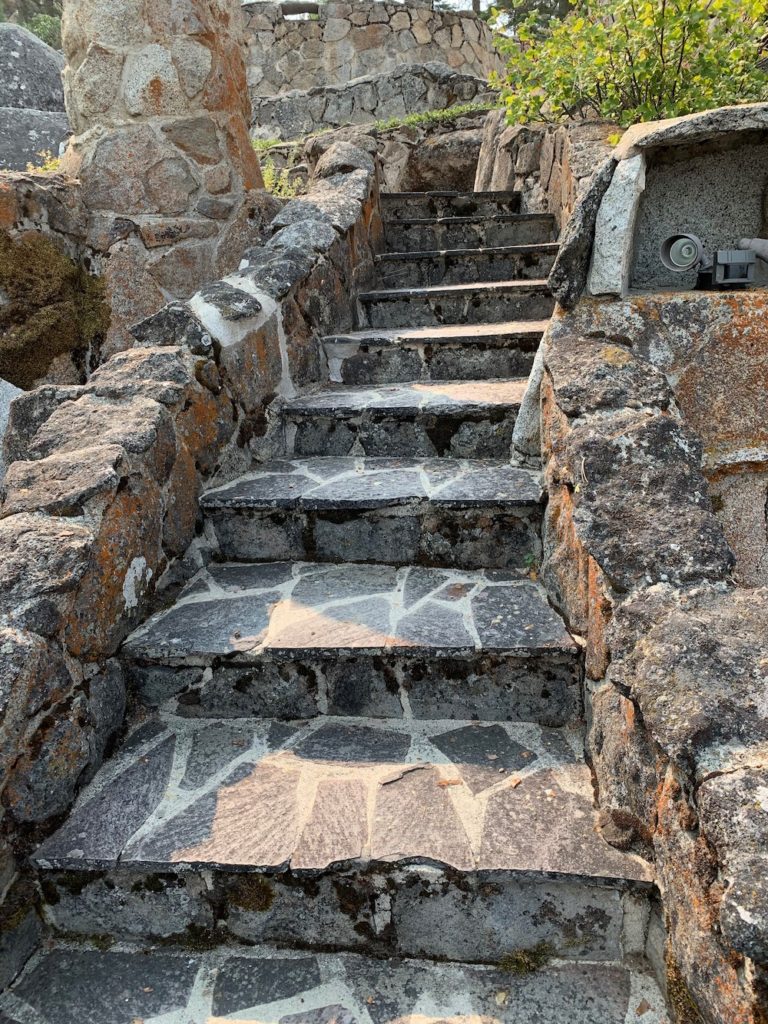A Lake Tahoe Castle In The Sky
Words: Ashley Johnson
Words: Ashley Johnson
Photos: Ashley Johnson, Thunderbird Lodge
Historic 1930s lakeside estate of George Whittell Jr., combines excellence in masonry craftsmanship with a harmonious architectural style.
Rising from the shores of East Lake Tahoe, in Incline Village, Nev., is a Castle in the Sky. Built-in 1936 by George Whittell Jr., a prominent and shrewd maverick and heir to a gold rush fortune, Thunderbird Lodge is a historic landmark now owned and operated by the nonprofit organization Thunderbird Lodge Preservation Society (TLPS).
Spanning a property that today sits at six acres, Thunderbird Lodge in its prime was the summer cottage and retreat of Whittell (pronounced Whi-tell). Its presence and endurance today represents much more than just a tourist destination and event venue.
Through his cunning business savvy and negotiation, Whittell acquired more than 40,000 acres of land, and 25 miles of shoreline, in Lake Tahoe from the Carson & Tahoe Lumber and Fluming Company. In addition to building Thunderbird Lodge right on the water, Whittell also planned to develop the acreage into high-end lakefront real estate, a ski run and hotel, and a casino at nearby Sand Harbor.
As Whittell grew older, he also grew to cherish his privacy that the undeveloped land and Thunderbird Lodge afforded. Rather than developing the land, he left it alone. Because of that decision, the eastern and western shores of Lake Tahoe remain largely untouched from any type of development.

The Man Behind The Mansion
Whittell was born into wealth in 1881 to Anna Luning and George Whittell Sr. His grandfathers made their fortunes during the gold rush era by investing in banking and real estate. On his Mother’s side, his grandfather helped found the San Francisco Water Company, a precursor to Pacific Gas and Electricity (PG&E).
A twin brother, Nicholas, died at four years old from Diptheria, leaving Whittell the sole heir to the family fortune. The Whittell family initially resided at a palatial estate in San Francisco’s Nob Hill neighborhood. However, it was completely demolished in the 1906 San Francisco earthquake.
At the time, 25-year-old Whittell already displayed an expensive predilection for fast automobiles. He drove his Duesenberg Model J through the rubble whisking family members to safety and saving precious family heirlooms and possessions.
After the destruction of the San Francisco estate, the Whittell family rebuilt in Woodside, Calif., where Whittell primarily spent his time until his death in 1969.
As the sole heir to the family fortune, Whittell embraced a lavish, carefree lifestyle enriched by fast cars, boats, airplanes, international travel, and multiple marriages. Despite graduating high school in San Francisco, he refused to attend college much to his parents dismay. Instead, Whittell is said to have joined Barnum and Bailey Circus.
During his short time with the circus, Whittell developed a passion and respect for wild animals, especially big cats. He used his substantial allowance to travel to Africa and capture exotic animals for the circus.
At his Woodside home, he possessed a menagerie of exotic pets that included elephants, bears, zebras, cheetahs, and lions. Some of these treasured pets traveled with Whittell during his summers at Thunderbird Lodge.
Whittell’s two most well-known pets were Mingo, a Sumatran pygmy Elephant, and Bill, an African lion received as a wedding gift in 1919 to his marriage of French heiress Elia Pascal.

While Mingo the elephant only spent one summer at Thunderbird Lodge, Bill traveled consistently with Whittell and was considered his most trusted companion. The distinguished duo could often be seen racing around in Whittell’s Duesenberg J-508 Weymann “Fishtail” Speedster, Bill’s front paws outstretched on the dashboard.
Building Thunderbird Lodge
In constructing Thunderbird Lodge, Whittell retained the services and expertise of local Nevada architect Frederick DeLongchamps, who designed and built a number of Nevada state buildings, as well as nine courthouses in Nevada and California.
Thunderbird Lodge experienced three unique designs before finally settling on the two-story Tudor-style estate with an architectural flair best described as rustic revival. Built on a concrete foundation, the walls of the 16,500-square-foot main Lodge are constructed from a softer grade of salmon-colored load-bearing granite and granite stone blocks quarried in Carson City.

The buildings exhibit steep roofs with dormers, symmetrical compositions, and rubblework stone walls with deep reveal and buttressed chimneys. The interior of the residence is simplistically elaborate with knotty pine throughout and dual staircases leading to the upper level. Because of Whittell’s aversion to overnight guests, the main lodge contained bedrooms only for Whittell and Pascal. Instead, guests stayed at the nearby cottages throughout the property.
A secret staircase tucked away in the main Lodge leads visitors downstairs to a kitchen outfitted with the original Servel Electrolux gas refrigerator and Wedgewood stove used to prepare all of Whittell’s meals. Also downstairs is a laundry room, maids’ quarters, and mechanical rooms that include a first-generation Carrier air conditioning unit.
Italian metalwork artist Anthony Soletti designed and hand-forged all of the property’s decorative exterior iron pieces that depict wildlife and mountain scenery. The one-of-a-kind fireplace screens throughout the buildings were hand-forged and feature unique themes. In the main Lodge, the immense chandelier was handcrafted by Soletti’s team of artisans, as well as all exterior iron embellishments of thunderbirds often seen above the buildings’ entrances.
In addition to the central home, the property features a gatehouse at the start of the property, three guest cottages, a card house, an elephant barn, a lighthouse, and a boathouse. A 600-foot tunnel blasted out of solid granite by Cornish miners allowed Whittell to discreetly travel between the Lodge and a steel boathouse occupied by the infamous Thunderbird Yacht.
Whittell commissioned famed naval architect John L. Hacker to design the Thunderbird, an art deco-style, 55-foot mahogany and stainless steel speed boat. Delivered in 1940 by Huskins Boat Works out of Bay City, Mich., the Thunderbird was powered by twin V-12, 550 horsepower, Kermath engines that reached speeds of 60 knots, or 70 miles per hour.
The Haunted Tunnel
The entrance to the 600-foot granite tunnel also resides downstairs, and at the time was accessible by a now defunct elevator. Inside the tunnel is an opium den with built-in seating and cushions for Whittell’s guests to lounge and carouse. Another custom fireplace screen by Soletti portrays two devils that emphasize the wicked and forbidden nature of the space.
Continuing on through the tunnel are multiple staircases and doors that serve no purpose other than to provide ventilation. Rails in the floor transported supplies directly from the lake to the Lodge. A windowless cell with an iron grate provided a refuge for Whittell’s pet lion Bill when the weather became too hot. It’s also rumored that Whittell’s guests who drank found themselves waking up in the cell with Bill licking their faces.
Also in the tunnel is an unfinished swimming pool that served as Whittell’s original boathouse before commissioning the Thunderbird. While the pool was being built, a worker tragically fell to his death from planks laid over the cavity.
Because of his superstitious nature, Whittell immediately halted construction and sealed up the space, leaving everything untouched and as is. Today the tunnel is said to be haunted with some visitors having heard voices, doors opening and closing, and other unexplained phenomena.
Around Thunderbird Lodge
While Thunderbird Lodge is steeped in history, rumors, and scandals, the gardens outside the Lodge are peaceful, picturesque, and manicured thanks to more than 40 gardening volunteers. An abundance of wildlife, native plant species, flowers, and trees call the gardens home, which are carefully and consistently watered, trimmed, and maintained on a year-round schedule.

The softly curving walkways that protect the gardens were constructed from a native gray stone likely procured onsite among the excavation remnants. Native American stonemasons from the Stewart Indian School in Carson City, Nev., designed, installed, and laid out the three-foot-wide granite flagstone walkways that connect the buildings.
At the center of the gardens and directly in front of the lodge are a series of fountains with three levels of cascading water that fall into a natural stone pond surrounded by lush vegetation and flowers. This water feature was not included in the original building plans. Restored in 2013, the waterfalls began as a construction ramp with an embedded railway that transported materials, supplies, and workers by cart down to the Lodge.
Water from nearby Marlette Creek was diverted through the property and fountains into moats and lagoons surrounding the residence. Today most of those original water features are filled in with garden beds and a lakeside lawn. Only the waterfalls remain.
The Cottages of Thunderbird Lodge
Situated throughout the property are several guest cottages, a card house, gatehouse, and an elephant barn that were built as scaled-down replicas of the Lodge.

The infamous card house allowed Whittell to host all-night, high-stakes poker games with celebrities like baseball legend Ty Cobb, professional boxer Jack Dempsey, and fellow recluse Howard Hughes.
Inside, the card house features a single open room with exposed stone walls, visible roof trusses with carved beams, fireplaces on each side, a large central chandelier, and a heated flagstone floor. When the cards were not in his favor, Whittell made his escape through a hidden staircase in the bathroom’s shower stall that led down to the tunnel.
Sitting high above the Lodge behind a granite stone retaining wall is the Cook Butler Cottage, offering an exterior flagstone patio with sweeping views of Lake Tahoe.
Featuring six dormers, two chimneys, and a steeply pitched gable roofline, the Cook Butler Cottage has been made available in the past to Thunderbird wedding couples for a mere $2,500.
Inside, the one-story cottage opens on a flagstone central foyer that separates the bedroom from the living area. Decorative iron light fixtures on the walls and ceiling complement separate fireplaces with Soletti-designed screens.
Just up the road from the Cook Butler Cottage is the Caretakers Cottage, which today accommodates a 24-hours maintenance and security caretaker.
Finally the Admiral’s Cottage is said to have originally accommodated Whittell’s captain of the Thunderbird Yacht. The multistory cottage features a kitchen with vintage appliances and antique furniture, a retro-style bathroom, and rustic living area featuring a fireplace covered by a Soletti-designed screen displaying dragon figures. An original 1930s telephone rests in an alcove next to the staircase leading to the upper floor, which contains two bedrooms.
Similar to the other cottages, the Admiral’s is composed of stone masonry with a projecting gabled entrance, iron sconces flanking the front door, and decorative chimney scenes depicting deer and trees.
A Modern Addition to Thunderbird Lodge
Whittell’s last visit to Thunderbird Lodge came in 1967. He passed away in 1969 from melanoma at 87 years old, leaving a majority of the property to animal protection organizations. The remaining property and adjoining 10,000 acres of land were purchased by New York Wall Street mutual fund guru and business savant Jack Dreyfus.

In 1985 Dreyfus began building a modern addition that sat around the original lighthouse and on the footprint of the Lodge’s original garages. Designed by Incline Village, Nev., architect Steven T. Sederquist, the expansion aspired to add value to the property by expanding the facilities. The renovation unified the new with the old by using similar materials, colors, and details. More specifically, the cedar shake roof on the new wing matched the old Lodge; accent colors for trim, rafters, and window sashes were replicated; and a new stone flue mirrored the existing Lodge chimney.
The renovation of Thunderbird Lodge also incorporated a glass-walled bridge leading to a 1,000 square-foot living room, called the Lighthouse Room. Today it functions as a conference space for events and meetings with an adjacent state-of-the-art kitchen.

Rounding out the Dreyfus addition is a master bedroom that today provides a reception room and museum store for tours, guests, and bridal parties. Just above are two guest rooms that now serve as administrative offices with stunning, unrivaled views.
Thunderbird Lodge Today
In 2000, Thunderbird Lodge was added to the National Register of Historic Places, and opened to the public two years later. Had it not been for the fortitude, insight, and appreciation of Chief Executive and Curator Bill Watson, Thunderbird Lodge might not be standing today. The Forest Service wanted to restore the land to its natural state by demolishing all the buildings.
Ownership of Thunderbird Lodge was conveyed to TLPS in 1999, while the surrounding land went to the USFS. Upon transfer of the Lodge, TLPS outlined a mission to inspire curiosity, appreciation, understanding and stewardship of Lake Tahoe’s art, history, and environment through preservation, education, and conservation. 
TLPS receives no government funding, instead of operating on a $1 million annual budget and maintaining the property entirely through charitable contributions, public tours, educational programs, corporate and social events, and a flagship membership program.
While forced to cancel its 2020 event season and public tours because of Covid-19, during normal years Thunderbird Lodge offers a number of activities and events.
One of the most sought after wedding destinations, Thunderbird Lodge allows a limited number of weddings each year. In addition to weddings, the Lodge has also been made available for Castle Dinners, corporate retreats, private tours, and of course cruises aboard the renowned Thunderbird Yacht.
Thunderbird Lodge hopes to reopen in 2021. To make a contribution or learn more about Thunderbird Lodge, visit www.thunderbirdtahoe.org